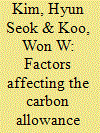| Srl | Item |
| 1 |
ID:
094872


|
|
|
|
|
| Publication |
2010.
|
| Summary/Abstract |
The US carbon allowance market has different characteristic and price determination process from the EU ETS market, since emitting installations voluntarily participate in emission trading scheme. This paper examines factors affecting the US carbon allowance market. An autoregressive distributed lag model is used to examine the short- and long-run relationships between the US carbon allowance market and its determinant factors. In the long-run, the price of coal is a main factor in the determination of carbon allowance trading. In the short-run, on the other hand, the changes in crude oil and natural gas prices as well as coal price have significant effects on carbon allowance market
|
|
|
|
|
|
|
|
|
|
|
|
|
|
|
|
| 2 |
ID:
162268


|
|
|
|
|
| Summary/Abstract |
The main concept of this paper is derived from the Government of Taiwan's Greenhouse Gas Reduction and Management Act (GGRMA), which mandates that greenhouse gas emissions in 2050 should be reduced to half of the rate of greenhouse gas emissions in 2005. To reach this carbon emission goal by 2050, this paper examines three potential policy options (each accompanied with four illustrative scenarios). The results show that: (1) it is impossible to reach the goals of the GGRMA solely through the use of carbon allowance allocations and the use of alternative fuels if the use of vehicles is allowed to grow. (2) By keeping the increase in the use of vehicles to zero, by encouraging a use of PHEVs, and by implementing a carbon allowance allocation, it will be possible to reach the government's 2050 carbon emissions goals. (3) If the use of vehicles can actually be reduced, it will be possible to achieve carbon emissions which are lower than the 2050 targets by 1.30–5.18%. The use of alternative fuels proves to be a reliable way to decrease carbon emission. Carbon emissions could also be lowered by encouraging the use of public transportation.
|
|
|
|
|
|
|
|
|
|
|
|
|
|
|
|